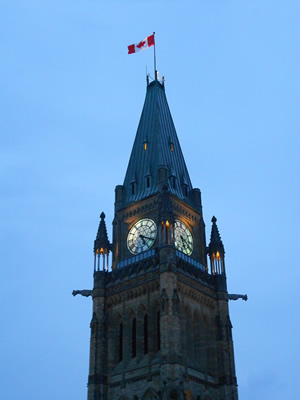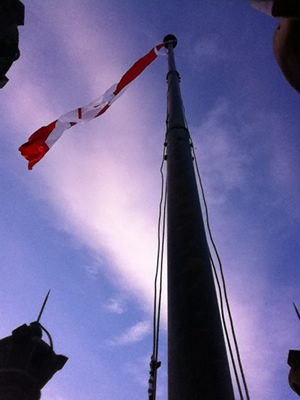Peace Tower
The Peace Tower, so named to honour the thousands of Canadian men and women who sacrificed their lives for their country in World War I, stands at the front of the Centre Block.
Like the present Centre Block, the Peace Tower differs markedly from the structure it replaced. While the old Victoria Tower was an integral part of the first Centre Block, the Peace Tower is a campanile, or freestanding bell tower.
Its walls are made of Nepean sandstone. They rise 97.9 m (321.2 ft.) high. The roof is reinforced concrete covered with copper. The Tower contains an observation deck, a clock with four faces 4.8 m (16 ft.) in diameter, a carillon and the Memorial Chamber, honouring Canada's war dead.
Changing of the Peace Tower Flag
The Peace Tower flag is changed every day, Monday to Friday, except on statutory holidays and days when it is flown at half-mast. For safety reasons, during poor weather conditions such as a snowstorm or high winds, the flag is not changed.
An experienced Public Works and Government Services Canada employee has the responsibility, among others, for the changing of the Peace Tower flag. Before climbing to the top of the Peace Tower, the employee unfolds the flag to ensure its quality, and then refolds it and places it in a bag. A folded flag weighs around 2.3 kg. The employee takes the elevator to the observation deck. From there, he climbs a total of 33 m using both stairs and ladders. The new flag must be prepared in the storage room and not on top of the Peace Tower, since the space on top is only 1.2 m x 1.2 m. For safety reasons, the employee uses a harness upon arrival at the top. The employee lowers the flag and then raises the new one to the top of the 10.7 m pole. The flag dimensions are 230 cm x 460 cm. As a sign of respect, the flag must not touch the ground.
The entire process to change the flag on the Peace Tower takes from 20 to 30 minutes.


Peace Tower Clock
Time passes, but certain key features of Parliament Hill remain unchanged. The clock in the Peace Tower, presented to Canada by the government of the United Kingdom to mark the 60th anniversary of Confederation, has been ticking in the heart of our capital since 1927. The original timekeeping mechanism built by British clockmakers no longer works and has since been replaced. The original mechanism is now exhibited inside a glass case in the observation area of the Peace Tower, visible to the public as they emerge from the elevator.
The clock faces have particular aesthetic value. They were assembled with great care and precision. The metal and glass faces are constructed of bronze segments bolted together. The glass sections, slotted into the frame, are held in place by small bronze angles and bedded in putty. The hands are made of riveted aluminum.
The clock faces are driven by an electric motor. The master clock that controls the electric motor driving the hands is located on the fifth floor of the Peace Tower. This master clock is set according to the time of the atomic clock at the National Research Council in Ottawa.
Did you know that the clock mechanism cannot be set back? As a consequence, when the clock is set back in the fall, a Public Works and Government Services Canada (PWGSC)employee stops the mechanism, located on the fifth floor of the Tower, and reactivates it an hour later. This time change is usually accomplished during the night.
To put the clock forward in the spring, all that needs to be done is to move the hand of the master clock on the fifth floor. When this is done, the timekeeping and chime mechanisms must be disconnected so that the chimes, set to sound every 15 minutes, do not ring during the process.
Carillon
Concerts are heard regularly on Parliament Hill from the Peace Tower carillon. The 54-t (60-ton) instrument, developed from the 17th century chiming clocks in Dutch and Flemish cities, contains 53 bells, ranging in size from the 4.5 kg (10 lb.) A-bell 16.6 cm (7 in.) in diameter to the 10,160 kg (22,400 lb.) bourdon tuned to E. It is the bourdon that strikes the hour.
The carillon is played from a large keyboard similar to that of an organ. To play, the keys are usually struck with the closed fist, but in the case of the heavier bells, which are fixed, the carilloneur must use his feet. Connected wires swing the clappers against the bells.
Musicians come from all over the world to study this superbly tuned carillon. The Peace Tower contains one of the earliest and finest carillons in North America.
Memorial Chamber
A central component of the Peace Tower is the Memorial Chamber, dedicated to the Canadian men and women who have given their lives in the service of their country.
The design of the Chamber is Gothic Revival. However, its high stained-glass windows, cusped arches and fan-vaulted ceiling create an atmosphere more in keeping with the memorial chapel of a cathedral.
The Memorial Chamber is rich with symbolism. The floor is made of stones taken from the World War I battlegrounds where Canadians fought. The walls and columns are faced with stone from France and Belgium; the two countries where Canadians saw the most combat. At the centre of the Chamber stands the central Altar carved from a block of Hopton Wood, the same British stone used for the tombstones in military cemeteries.
The central Altar, and similar altars in the Chamber, contains the Books of Remembrance, inscribed with the names of Canadians who have died in battle.
Stone Carvings
What are those stone figures and carvings staring down from the Peace Tower of the Centre Block on Parliament Hill? Some are fanciful human figures; some are animal figures, while others portray lurid ancient creatures.
Whatever they are, all of them are original carvings that were incorporated into the Gothic Revival architectural style of the buildings on Parliament Hill.
There are still many uncarved blocks of stone in the interior of the Centre Block that are waiting to be transformed into notable works of art.
Although the carvings are generally referred to as gargoyles, there is a descriptive difference between "gargoyles" and "grotesques", "friezes" and "bosses".
Gargoyles were created with a two-fold practical purpose. First, to ward off evil and, second, to eject excess water from the exterior of buildings. A gargoyle, although sometimes mistaken for a grotesque, is a spout or eaves trough carved in the form of a human or animal figure projecting from a roof gutter to catch rainwater and throw it clear of a building.
A grotesque is a style of decorative art characterized by fanciful human or animal figures that may distort the natural into absurdity, ugliness or caricature. At the turn of the century, grotesques were carved as designs of figures for decoration or adornment on buildings. At the same time, they were made to symbolize a desire to fight the power of evil.
Some grotesques or reliefs were carved onto a frieze, which is a horizontal band of decoration around the upper section of a wall, often ornamented with sculpture.
The term boss is used to describe an ornamental projecting block that can be found at the end of a moulding or an arch.
Grotesques
Four of the many grotesques that can be found on the Peace Tower are made from Wallace sandstone (olive green) from Wallace, Nova Scotia, Canada. They are each approximately 105 cm (42 in.) high by 55 cm (22 in.) wide.
Reliefs
A number of decorative relief carvings can be found on the many friezes on the Peace Tower. These have been sculpted from Wallace sandstone (olive green) from Wallace, Nova Scotia, Canada and vary in size.
Bosses
Many bosses can be found on the Peace Tower. Some are carved from Wallace sandstone (olive green) from Wallace, Nova Scotia, Canada, others are carved from Birmingham buff sandstone from Ohio, United States of America.
Gargoyles
There are four gargoyles on the Peace Tower. Each is approximately 2.5 m (8 ft. 4 in.) long by 75 cm (2 ft. 6 in.) high by 45 cm (1 ft. 6 in.) thick. They have been carved from Stan stead grey granite, which originates from Beebe, Quebec, Canada.
- Date modified: